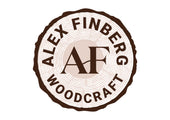Sean kindly lent me a prototype stock knife kit to try. I’ve since become an avid user, here’s my thoughts on getting to know this versatile tool.
For those wondering what this guillotine like contraption is and does – this is a Stock knife kit, complete with a versatile bench and jig for a range of woodworking projects. It is modelled on the concept of the French Paroirs de sabotier or clog maker’s knife, which featured a long slightly curved blade, slotted into a bench ring and used in a slicing motion to give the final shape to wooden clogs.
The Paroirs is a much sought after tool here in the UK - albeit by a niche of spoon carvers and green woodworkers - but sadly its not everyday us green woodworkers get the chance to peruse French flea markets and come upon a paroirs in good condition.

Stock Knife Kit Setup on a four legged chopping block
English clog makers tools are also very hard to come by and although adaptable they were designed with the specific function of carving wooden clogs – the stock knife Sean has forged on the other hand is a modern versatile tool with a shorter blade length, designed for spoon carving and a range of woodworking projects, from sculptural carving to bowls and kuksas.
Stock Knife Kit
The stock knife comes as a kit, along with the knife itself Sean supplied a hardwood base and ‘stepped’ blocks to slice onto. The knife itself did not come with a sheath but I made a rudimentary hardwood sheath with elastic ties to secure it – this blade is long and very sharp – you require protection as much as it does!
The cutting edge is markedly shorter than the clog makers Paroirs which can measure upwards of 60cm. The handle is fairly long giving plenty of mechanical advantage via leverage. This means it is not one to sling in the rucksack, but you wouldn’t want to flash this knife around in public anyway, it is a workshop tool or tool to be used in a dedicated workspace

The kit does take a bit of getting used to and requires a dedicated workspace. It can be clamped into a workshop vice, and used alongside a workbench with ease. If your vice is located at the corner of you bench, this is preferable, as you will need to shift your body position around a fair deal, one of the things I like about this tool is it engages your body holistically and uses the inherent strength of body mechanics to aid carving – more on that later.

The knife itself slots into the bench ring, which is ingeniously sprung to keep it from slipping out. The ‘stepped’ blocks can be orientated to your desired angle, and then you are ready to slice.
Carving
Using long slicing cuts the knife excels at taking both long facets, short nibbles of endgrain and even concave cuts in a surprisingly versatile manner. Shifting your workpiece as close to the bench ring as possible really maximises the power you can deliver through each cut.
The knife has been forged from O1 Steel tempered to 59 -61 hardness and given a flat over hollow grind on its back, and a short bevel on the front, giving it a robust edge which is easy to maintain. It has a lengthy tang and is a powerful and robust tool. This tool, like all tools, does have its limits, the weak point is the tang between the knife and the handle which could be prone to snapping or bending if using extreme force. Refrain from taking huge chunks from end=grain and it will do all that you ask of it.

Carving Facets into a Cooking Spoon
I have thoroughly enjoyed using it for facets on the handles of eating spoons, kuksa end grain and bowl carving. It uses a different set of muscles and body mechanics to axe carving which is proving refreshing and good for my body.
Pros
- Excels at end-grain
- Removes the repetitive strain of axing
- A versatile tool for a range of woodworking projects
- Hollow ground and straightforward to maintain
Cons
- Requires practice setting up & using
- Takes up a bit of workshop space
- Requires a sheath

Carving a Cooking Spoon with a Stock Knife
Overall
If you are looking to vary and make production carving more efficient, or want a way to produce woodenware without hacking off the neighbours with repetitive axing, or want to reduce repetitive strain injuries and make your workflow more efficient this knife will do all of this and become a much valued member of your toolkit.
For More Information Visit:
https://seanhellman.com/

